Test your pangolin knowledge!
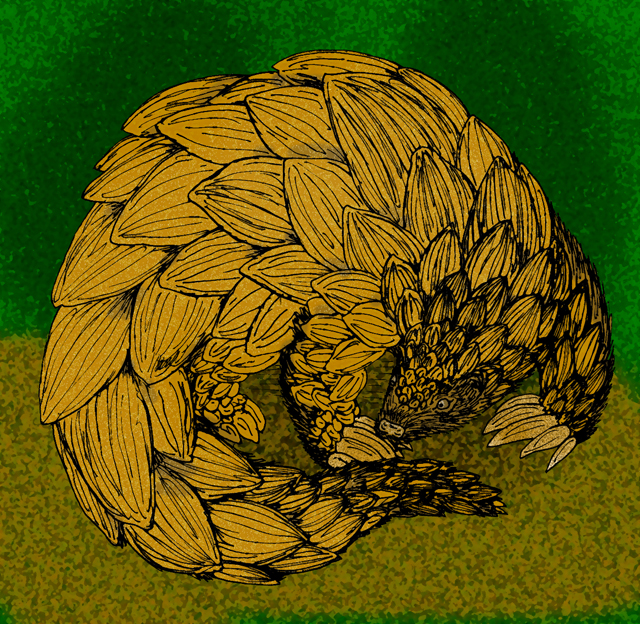
Want to learn more about pangolins? Check out this comprehensive list!
- There are a total of eight species of pangolin on our planet. Four live in Asia:
- Thick-tailed Pangolin (also called Indian Pangolin), Manis crassicaudata — ‘Near Threatened’
- Phillipine Pangolin, Manis culionensis — ‘Near Threatened’
- Sunda Pangolin (also called Malayan Pangolin), Manis javanica — ‘Endangered’
- Chinese Pangolin, Manis pentadactyla — ‘Endangered’
- Three-Cusped Pangolin (also called African White-Bellied Pangolin and Tree Pangolin), Phataginus tricuspis — ‘Near Threatened’
- Giant Ground Pangolin, Smutsia gigantea — ‘Near Threatened’
- Cape Pangolin (also called Temminck’s Pangolin), Smutsia temminckii — ‘Least Concern’
- Long-Tailed Pangolin (also called Black-Bellied Pangolin), Uromanis tetradactyla — ‘Least Concern’
- Pangolins, also known as scaly anteaters, are unique creatures that are covered in hard, plate-like scales. They are insectivorous (feeding on insects) and are mainly nocturnal. Their name, “pangolin”, is derived from the Malay word “pengguling”, which loosely translates to “something that rolls up”. Together, the eight species comprise their very own Order: Pholidota.
- Though many may believe them to be related to anteaters, sloths, and armadillos, Texas A&M University’s Biology Department explains that they are actually thought to be most closely related to true Carnivores (Order Carnivora). However, their relationships to other animals are not clear.
- According to the International Union for the Conservation of Nature (IUCN), virtually no information is available on population levels of any species of pangolin. These species are rarely observed due to their secretive, solitary, and nocturnal habits, and there has been little research on their population densities. However, all species are thought to be in decline, with some more rapidly so than others — particularly the Asian species.
- Pangolins have large, curved claws that
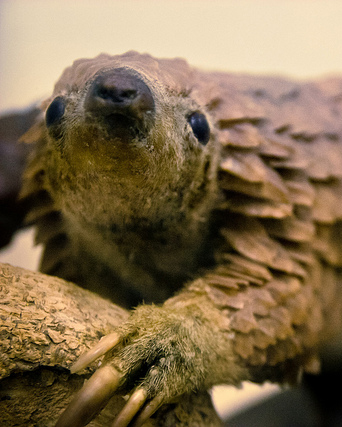 they use for excavating ant and termite nests, as well as for pulling bark off trees and logs to find their insect prey.
they use for excavating ant and termite nests, as well as for pulling bark off trees and logs to find their insect prey. - Pangolins’ scales are made of keratin, the same protein that makes up our own hair and nails, rhino horns, the “teeth” of baleen whales, and the claws of bears (and other clawed animals). Their scales cover the entire body from head to tip of tail — except for their undersides, which are covered with a few sparse hairs.
- Scaly anteaters are said to reach sexual maturity after two years, and typically only give birth to a single young per pregnancy. Their gestation period is thought to last between 69–150 days, varying by species. When born, the babies weigh around 8-450 grams (about 3-16 ounces), depending on the species, and have soft scales that harden fairly rapidly. Young are usually weaned at around three months of age.
- Special glands near the animal’s anus secrete a pungently odorous fluid that is used for marking its territory. Like many other animals, they also scent mark with their feces and urine.
- The scales of these critters comprise about 20% of their total body weight.
- When pangolins feel threatened, they curl up into a tight, almost impenetrable ball to protect their tender undersides. If caught, they will thrash about using their tail muscles. Because their scales have very sharp edges, they can slice the skin of a human or predator when they do this. They may also release the stinky fluid from their glands as a defense mechanism.
- They do not have teeth and are unable to chew. Instead, they have long sticky tongues that they use to catch the insects they feed on.
- Some species, such as the Long-tailed pangolin, have prehensile tails that help in climbing in trees and hanging from branches.
- When the pangolin’s tongue is fully extended, it can be up to 16 inches (over 40 centimeters) longer than its entire body length! In fact in most species, their tongues actually start deep in their chest cavity, arising from the last pair of ribs, and are about a quarter inch (0.6 cm) thick. Additionally, their sticky saliva coats their tongues to help the bugs.
- The Chinese and the Sunda pangolins are the most endangered of all eight species. In the case of the latter, their numbers began to decline quite rapidly around 1990 and the population has been halved over just the last 15 years. The IUCN reports that Chinese pangolins have also been greatly reduced over this time period. Despite being protected by CITES, poaching is decimating these (and other) species.
- These animals can voluntarily constrict their ears and nostrils to keep insects out while they are feeding.
- The biggest threat to all pangolin species today is
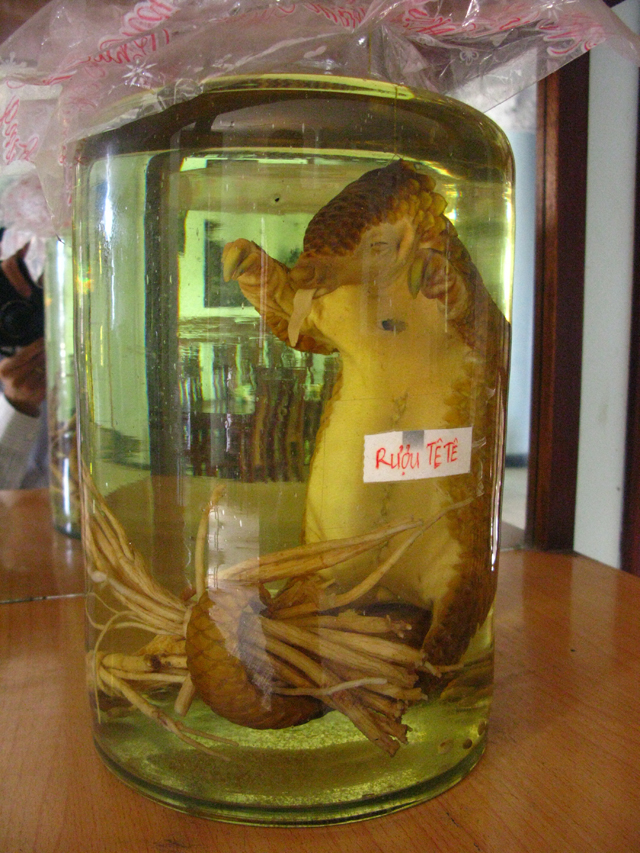 illegal, commercial hunting for human consumption. African species are largely hunted as bushmeat, but there also seems to be some regional use of their scales and other body parts in folk medicines and cultural traditions and rituals. In China and Vietnam (the primary sources of demand for pangolins), the flesh of both adult and fetuses is considered a delicacy and some mistakenly believe they will be blessed with health benefits if they eat it. Their scales, blood, and other body parts are also widely used in traditional Chinese medicines (TCMs) and ‘health tonics’. There is mounting concern that African pangolins will increasingly be targeted to supply the burgeoning Far East demand for these animals, as Asian species’ populations continue to plummet toward extinction. In fact, recent events suggest this may already be happening.
illegal, commercial hunting for human consumption. African species are largely hunted as bushmeat, but there also seems to be some regional use of their scales and other body parts in folk medicines and cultural traditions and rituals. In China and Vietnam (the primary sources of demand for pangolins), the flesh of both adult and fetuses is considered a delicacy and some mistakenly believe they will be blessed with health benefits if they eat it. Their scales, blood, and other body parts are also widely used in traditional Chinese medicines (TCMs) and ‘health tonics’. There is mounting concern that African pangolins will increasingly be targeted to supply the burgeoning Far East demand for these animals, as Asian species’ populations continue to plummet toward extinction. In fact, recent events suggest this may already be happening. - Despite the fact that scientific studies have proven that keratinous body parts of other animals (e.g. rhino horns) are void of any medicinal or curative properties, many continue to consume pangolin scales as a TCM remedy for a wide variety of health problems, such as reducing swelling, promoting blood circulation, and stimulating lactation in breast-feeding women. More recently, rumors likely spawned by Chinese pangolin “farming” business ventures have falsely claimed pangolin-derived TCMs can even cure cancer. As a result of the black market demand for these animals, an estimated 41,000-60,000 pangolins were plundered from the wild in 2011 alone.
- As these creatures lack teeth, stomach contents are ground with small pebbles to aid in digestion — kind of like a bird’s gizzard. Their lower stomach (the pyloric region) are also lined with strange spine-like protrusions that point inward toward the center of the organ.
- Pangolins have poor vision and hearing, but their sense of smell is quite strong.
- The illicit pangolin trade has become extremely lucrative. According to Environmental News Network, pangolins were worth around US $10 per kilo in the early 1990s and had soared to US $175 per kg by 2009. Wildlife Alliance’s Suwanna Gauntlett explained in an interview with Mongabay guest writer, Laurel Neme, that the going rate had reached a whopping US $200 per kilogram in 2011.
- It’s believed that a single pangolin consumes more than 70 million insects per year. They mainly eat ants and termites.
Watch some pangolin pest control in action in this video from National Geographic!
- Some species find shelter in trees, while others live in underground burrows.
- Baby pangolins travel around with their mothers by riding on the base of her tail.
- Giant ground pangolins are the largest of all eight species. One was found to weigh 33 kilograms (72.6 pounds) — the largest pangolin ever recorded! Long-tailed pangolins are the smallest, weighing around 2-3 kg (about 4-6 pounds).
- While some poachers kill the animal when they catch it, other times they may be kept alive by request from restaurants where they are destined for the dining table. A 2007 article in The Guardian quotes a Guangdong chef explaining the disturbing way in which the pangolins are prepared for the diners.
“We keep them alive in cages until the customer makes an order. Then we hammer them unconscious, cut their throats and drain the blood. It is a slow death. We then boil them to remove the scales. We cut the meat into small pieces and use it to make a number of dishes, including braised meat and soup. Usually the customers take the blood home with them afterwards.”
Four others live in Africa:
Author: Sarah Pappin. Read more about Sarah here.
Want to help? Check out our pangolin t-shirts: Project Pangolin is contributing $2.00 per t-shirt or hoodie to Education for Nature-Vietnam.
Sources:
Cota-Larson, R., “11 Things You Didn’t Know About Pangolins,” Project Pangolin
Myers, P., “Pholidota,” Animal Diversity Web, accessed 17 February, 2012
Pappin, S., “8 Things Everyone Should Know About the Booming Illicit Pangolin Trade,” Project Pangolin
“What Is A Pangolin?,” SavePangolins.org, accessed 17 February, 2012
Image #1 by Apokryltaros via Wikimedia Commons
Image #2 by Odin Zebest on Flickr
Image #3 © Pam Krzyza
Image #4 by Phó Nháy via Wikimedia Commons


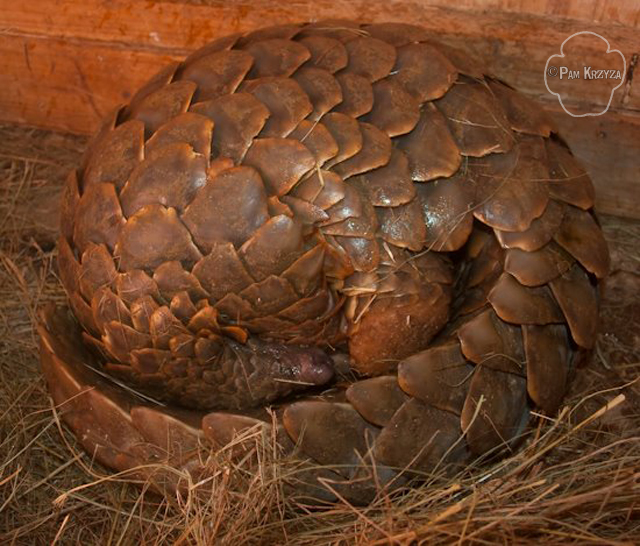
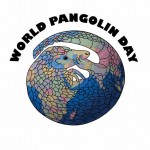
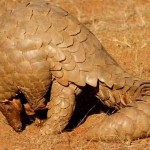

8 Comments
Comments are closed.